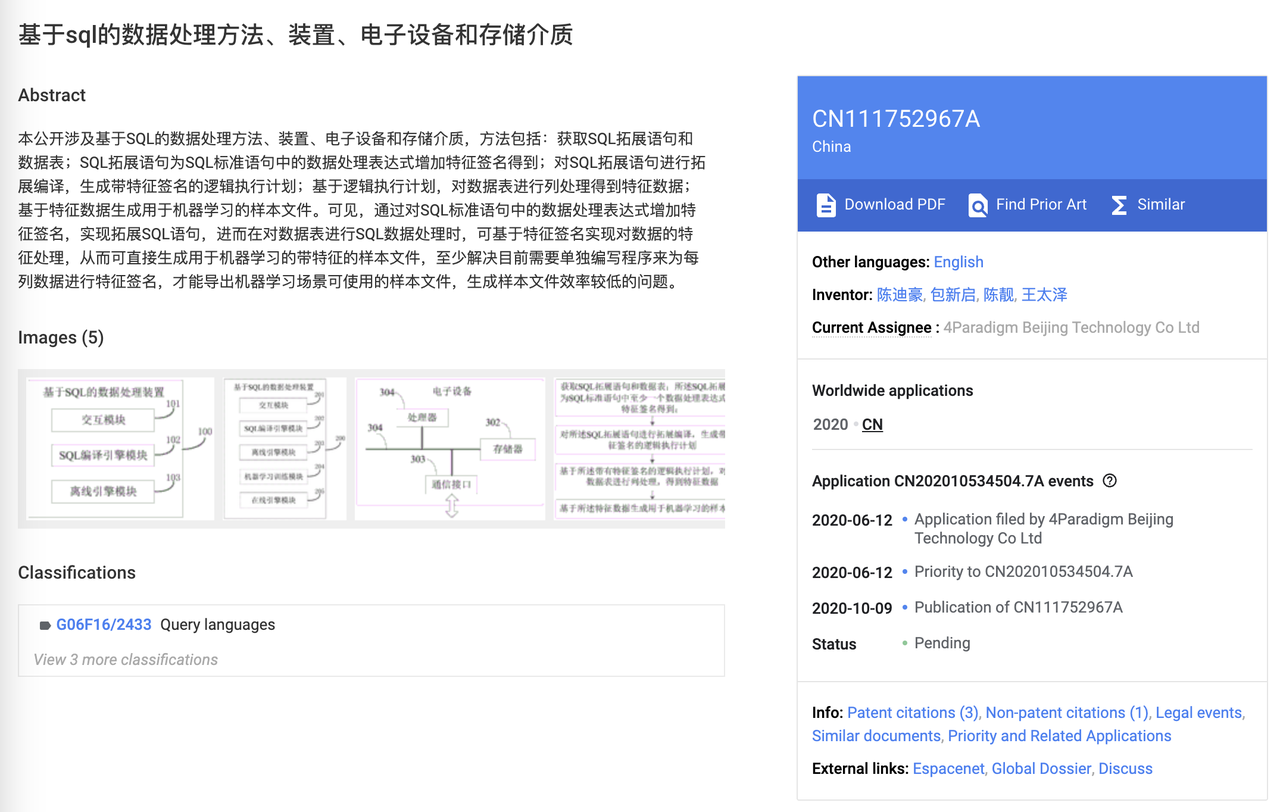Introducing OpenMLDB’s New Feature: Feature Signatures — Enabling Complete Feature Engineering with SQL
Contents
Introducing OpenMLDB’s New Feature: Feature Signatures — Enabling Complete Feature Engineering with SQL#
Background#
Rewinding to 2020, the Feature Engine team of Fourth Paradigm submitted and passed an invention patent titled “Data Processing Method, Device, Electronic Equipment, and Storage Medium Based on SQL”. This patent innovatively combines the SQL data processing language with machine learning feature signatures, greatly expanding the functional boundaries of SQL statements.

At that time, no SQL database or OLAP engine on the market supported this syntax, and even on Fourth Paradigm’s machine learning platform, the feature signature function could only be implemented using a custom DSL (Domain-Specific Language).
Finally, in version v0.9.0, OpenMLDB introduced the feature signature function, supporting sample output in formats such as CSV and LIBSVM. This allows direct integration with machine learning training or prediction while ensuring consistency between offline and online environments.
Feature Signatures and Label Signatures#
The feature signature function in OpenMLDB is implemented based on a series of OpenMLDB-customized UDFs (User-Defined Functions) on top of standard SQL. Currently, OpenMLDB supports the following signature functions:
continuous(column): Indicates that the column is a continuous feature; the column can be of any numerical type.discrete(column[, bucket_size]): Indicates that the column is a discrete feature; the column can be of boolean type, integer type, or date and time type. The optional parameterbucket_sizesets the number of buckets. Ifbucket_sizeis not specified, the range of values is the entire range of the int64 type.binary_label(column): Indicates that the column is a binary classification label; the column must be of boolean type.multiclass_label(column): Indicates that the column is a multiclass classification label; the column can be of boolean type or integer type.regression_label(column): Indicates that the column is a regression label; the column can be of any numerical type.
These functions must be used in conjunction with the sample format functions csv or libsvm and cannot be used independently. csv and libsvm can accept any number of parameters, and each parameter needs to be specified using functions like continuous to determine how to sign it. OpenMLDB handles null and erroneous data appropriately, retaining the maximum amount of sample information.
Usage Example#
First, follow the quick start guide to get the image and start the OpenMLDB server and client.
docker run -it 4pdosc/openmldb:0.9.2 bash
/work/init.sh
/work/openmldb/sbin/openmldb-cli.sh
Create a database and import data in the OpenMLDB client.
--OpenMLDB CLI
CREATE DATABASE demo_db;
USE demo_db;
CREATE TABLE t1(id string, vendor_id int, pickup_datetime timestamp, dropoff_datetime timestamp, passenger_count int, pickup_longitude double, pickup_latitude double, dropoff_longitude double, dropoff_latitude double, store_and_fwd_flag string, trip_duration int);
SET @@execute_mode='offline';
LOAD DATA INFILE '/work/taxi-trip/data/taxi_tour_table_train_simple.snappy.parquet' INTO TABLE t1 options(format='parquet', header=true, mode='append');
Use the SHOW JOBS command to check the task running status. After the task is successfully executed, perform feature engineering and export the training data in CSV format.
Currently, OpenMLDB does not support overly long column names, so specifying the column name of the sample as instance using SELECT csv(...) AS instance is necessary.
--OpenMLDB CLI
USE demo_db;
SET @@execute_mode='offline';
WITH t1 as (SELECT trip_duration,
passenger_count,
sum(pickup_latitude) OVER w AS vendor_sum_pl,
count(vendor_id) OVER w AS vendor_cnt,
FROM t1
WINDOW w AS (PARTITION BY vendor_id ORDER BY pickup_datetime ROWS_RANGE BETWEEN 1d PRECEDING AND CURRENT ROW))
SELECT csv(
regression_label(trip_duration),
continuous(passenger_count),
continuous(vendor_sum_pl),
continuous(vendor_cnt),
discrete(vendor_cnt DIV 10)) AS instance
FROM t1 INTO OUTFILE '/tmp/feature_data_csv' OPTIONS(format='csv', header=false, quote='');
If LIBSVM format training data is needed, simply change SELECT csv(...) to SELECT libsvm(...). Note that the OPTIONS should still use the CSV format because the exported data only has one column, which already contains the complete LIBSVM format sample.
Moreover, the libsvm function will start numbering continuous features and discrete features with a known number of buckets from 1. Therefore, specifying the number of buckets ensures that the feature encoding ranges of different columns do not conflict. If the number of buckets for discrete features is not specified, there is a small probability of feature signature conflict in some samples.
--OpenMLDB CLI
USE demo_db;
SET @@execute_mode='offline';
WITH t1 as (SELECT trip_duration,
passenger_count,
sum(pickup_latitude) OVER w AS vendor_sum_pl,
count(vendor_id) OVER w AS vendor_cnt,
FROM t1
WINDOW w AS (PARTITION BY vendor_id ORDER BY pickup_datetime ROWS_RANGE BETWEEN 1d PRECEDING AND CURRENT ROW))
SELECT libsvm(
regression_label(trip_duration),
continuous(passenger_count),
continuous(vendor_sum_pl),
continuous(vendor_cnt),
discrete(vendor_cnt DIV 10, 100)) AS instance
FROM t1 INTO OUTFILE '/tmp/feature_data_libsvm' OPTIONS(format='csv', header=false, quote='');
Summary#
By combining SQL with machine learning, feature signatures simplify the data processing workflow, making feature engineering more efficient and consistent. This innovation extends the functional boundaries of SQL, supporting the output of various formats of data samples, directly connecting to machine learning training and prediction, improving data processing flexibility and accuracy, and having significant implications for data science and engineering practices.
OpenMLDB introduces signature functions to further bridge the gap between feature engineering and machine learning frameworks. By uniformly signing samples with OpenMLDB, offline and online consistency can be improved throughout the entire process, reducing maintenance and change costs. In the future, OpenMLDB will add more signature functions, including one-hot encoding and feature crossing, to make the information in sample feature data more easily utilized by machine learning frameworks.
For more information on OpenMLDB:
Official website: https://openmldb.ai/
Documentation: https://openmldb.ai/docs/en/
Join us on Slack!
This post is a re-post from OpenMLDB Blogs.
